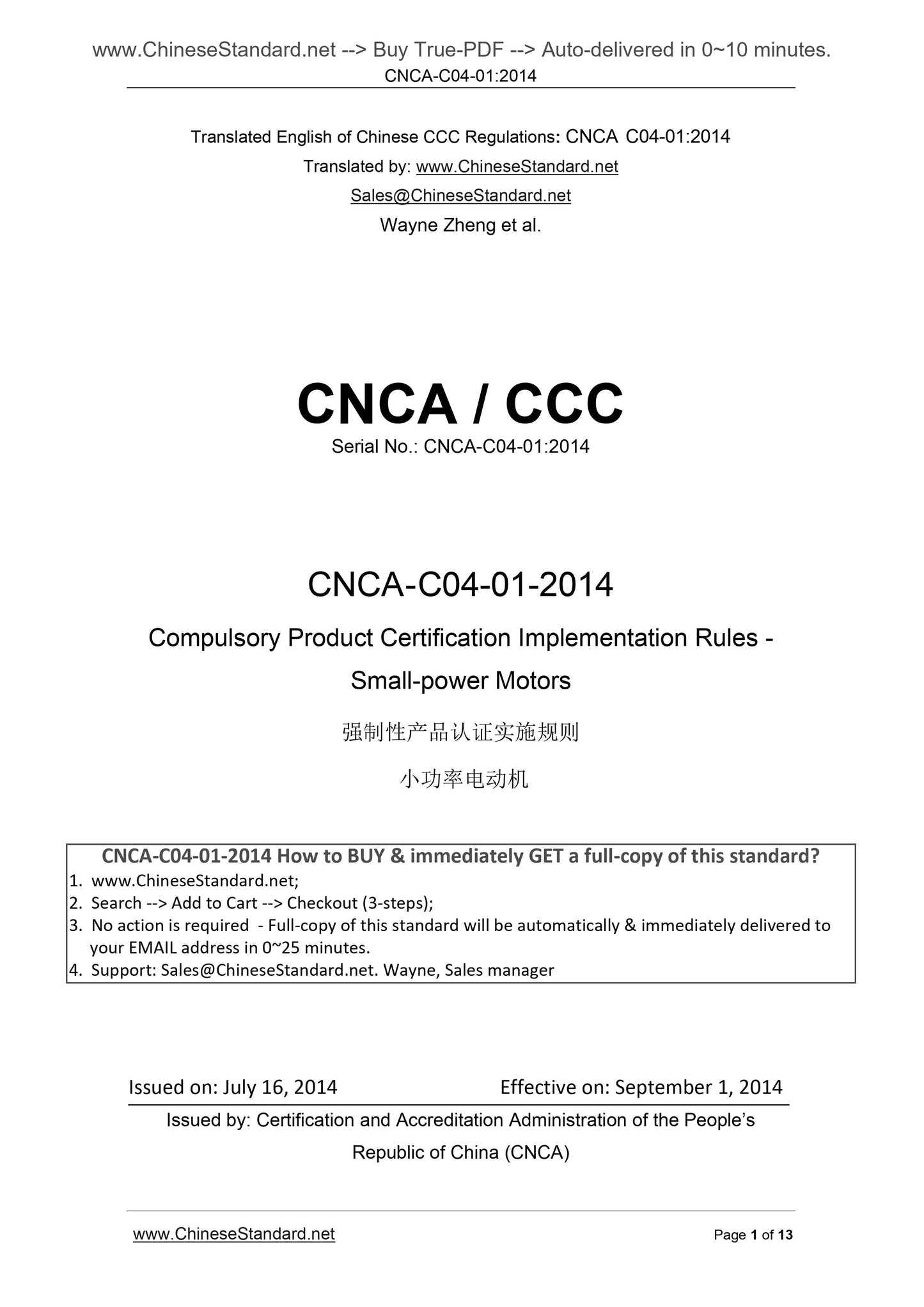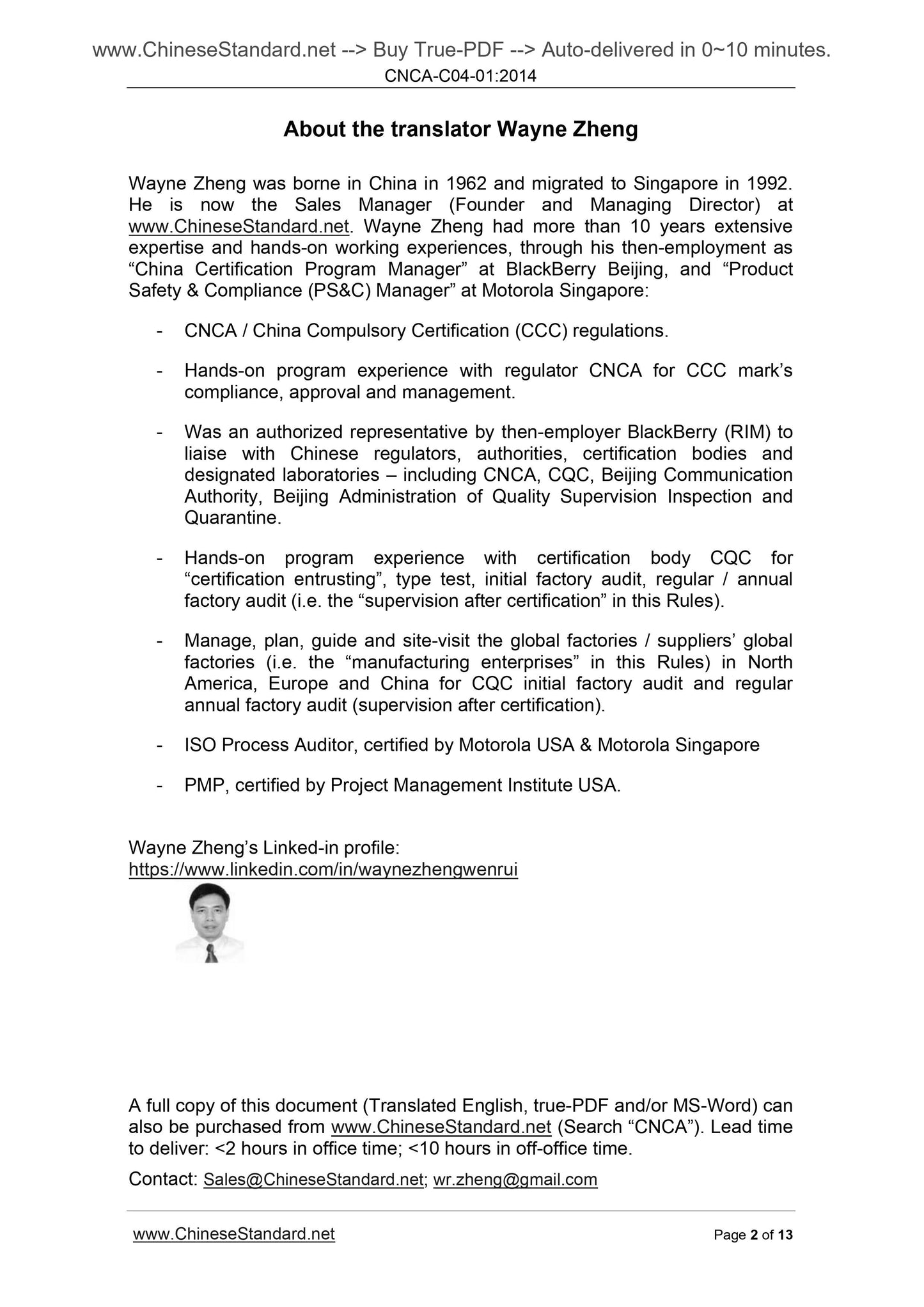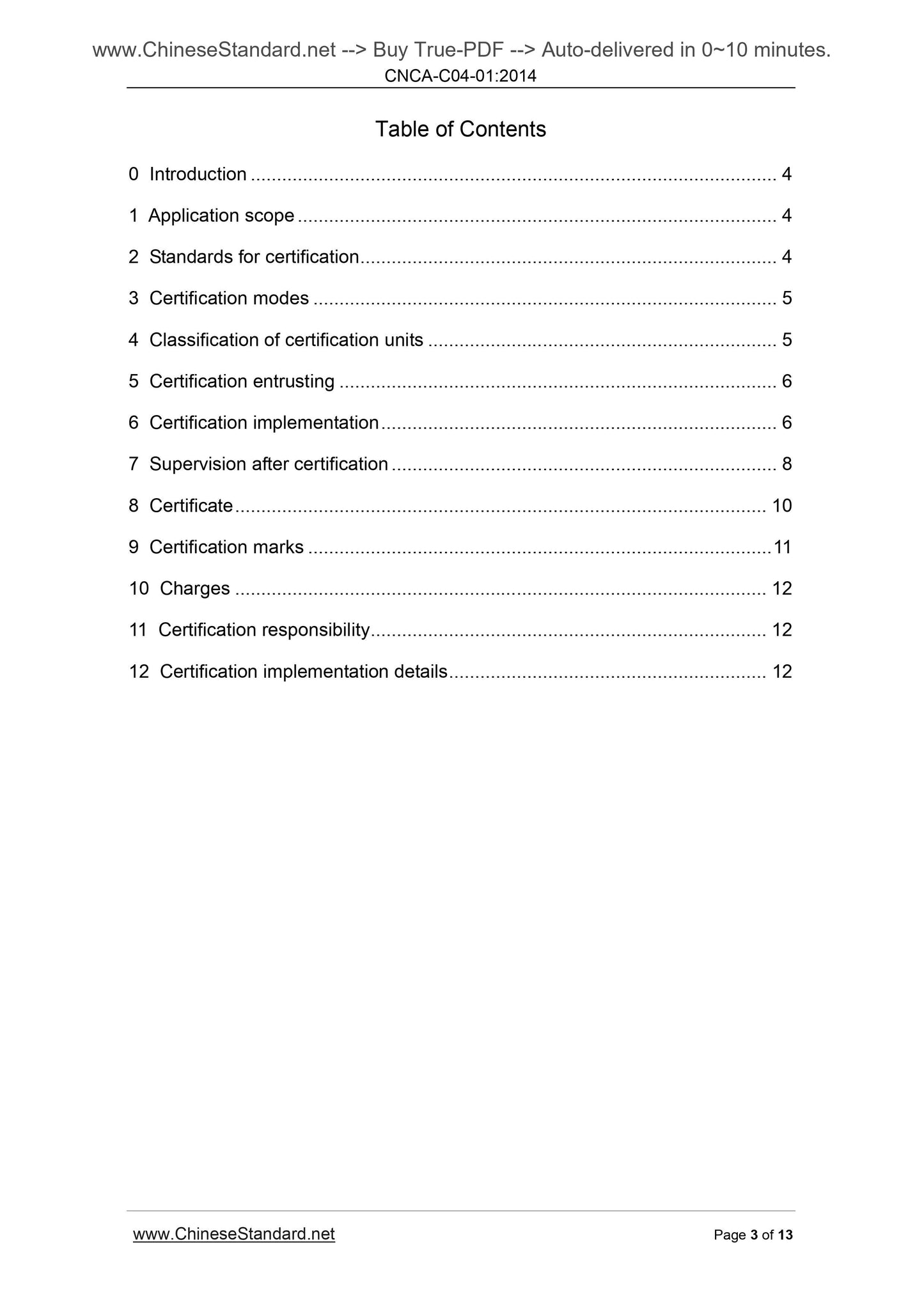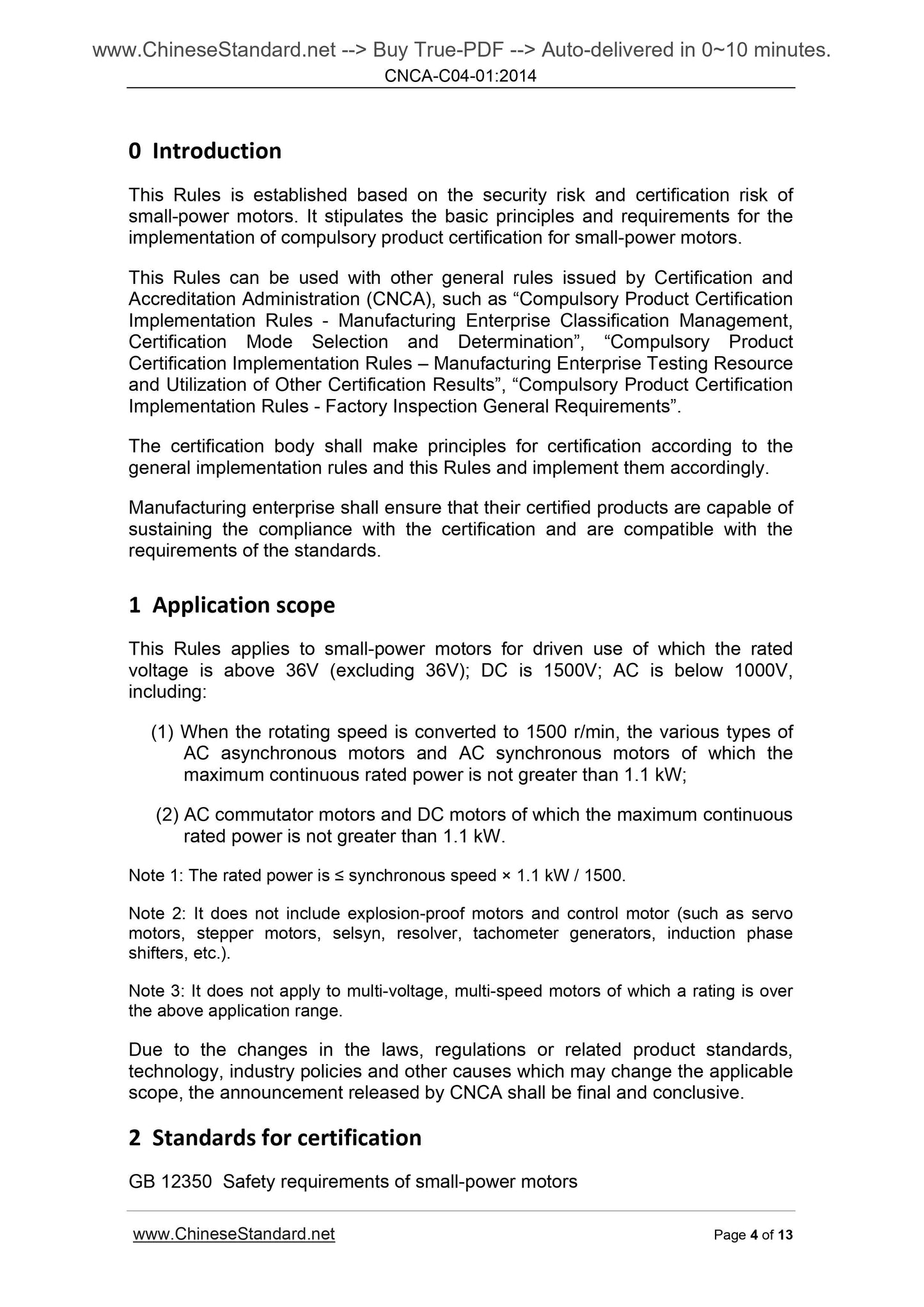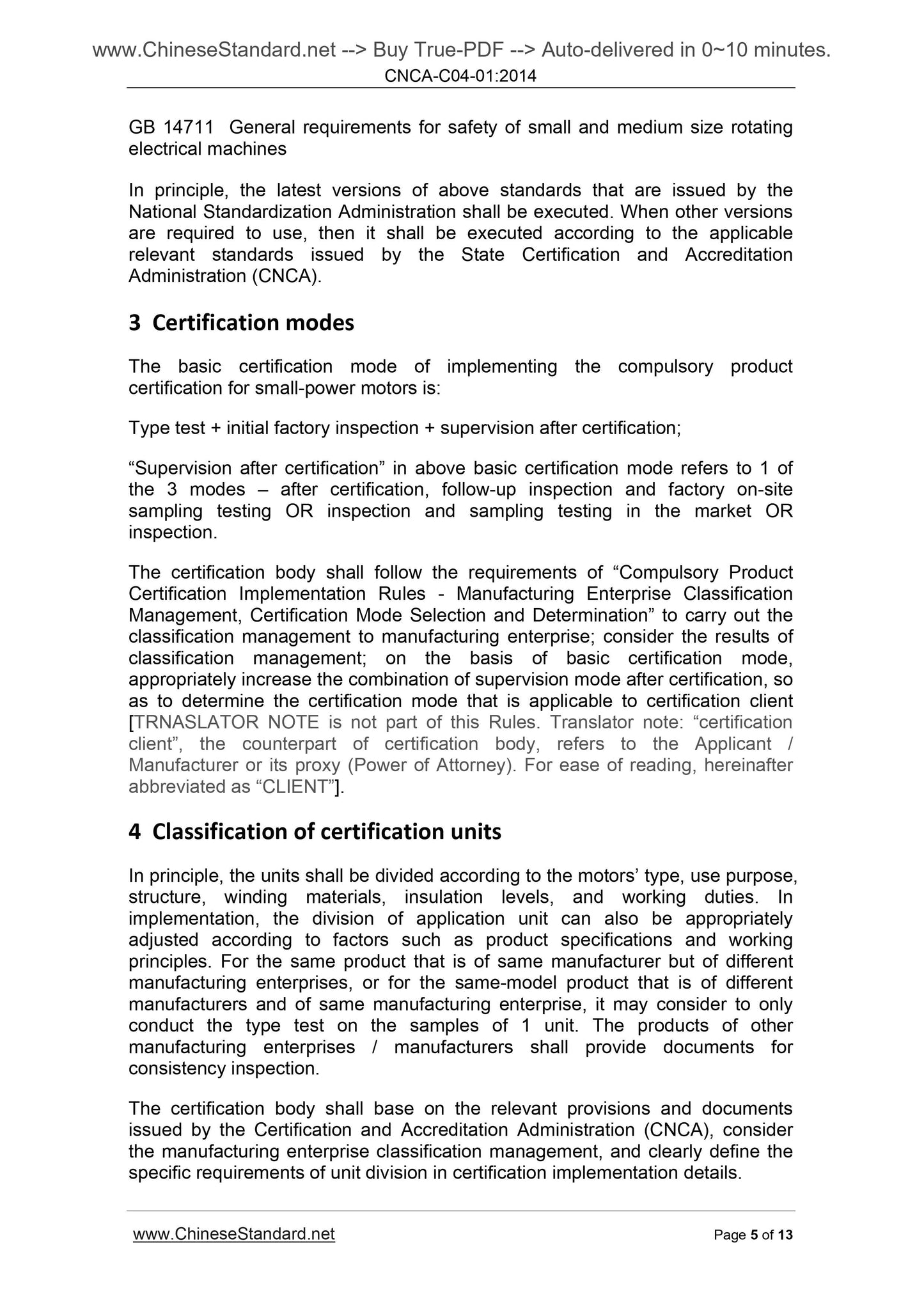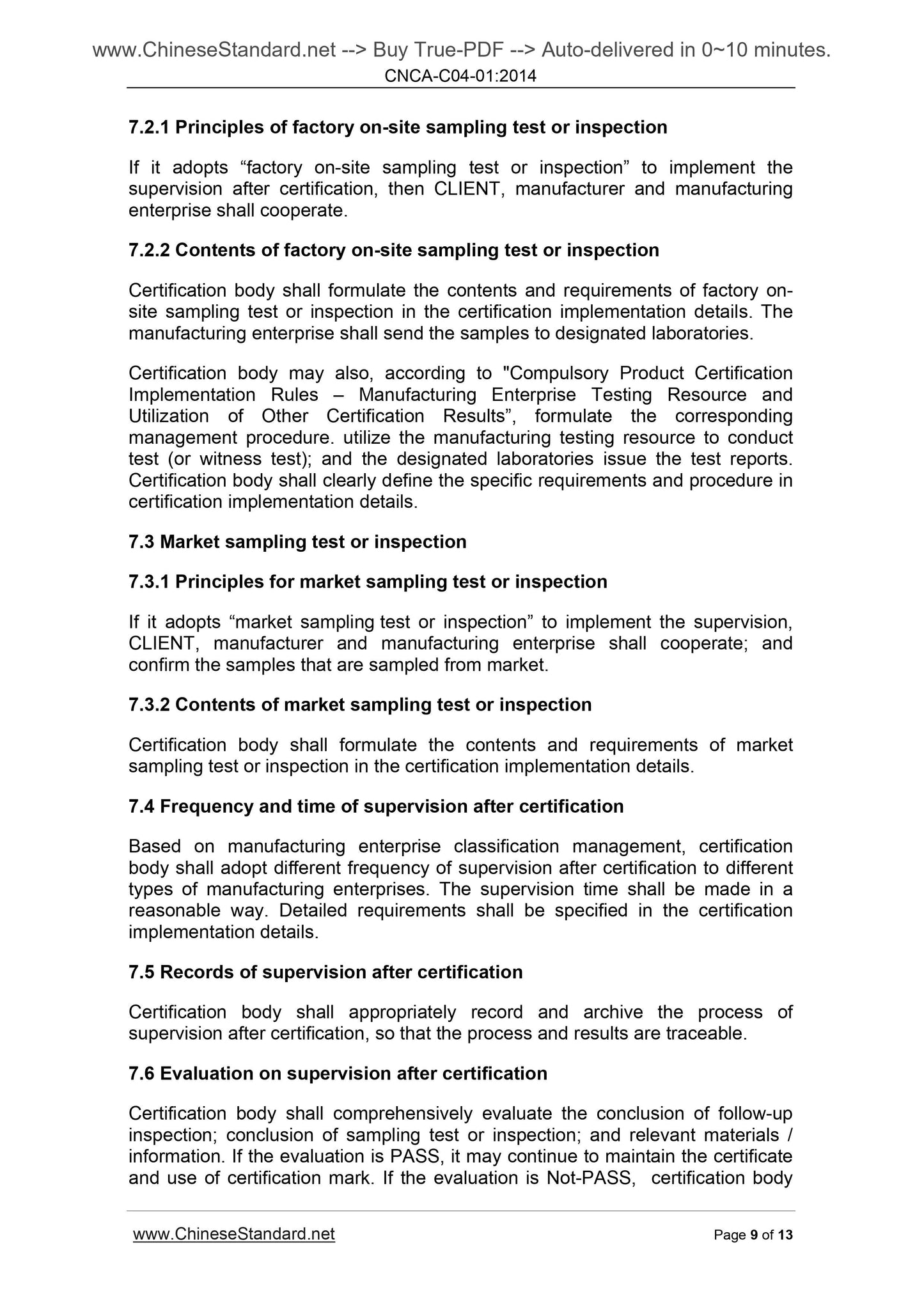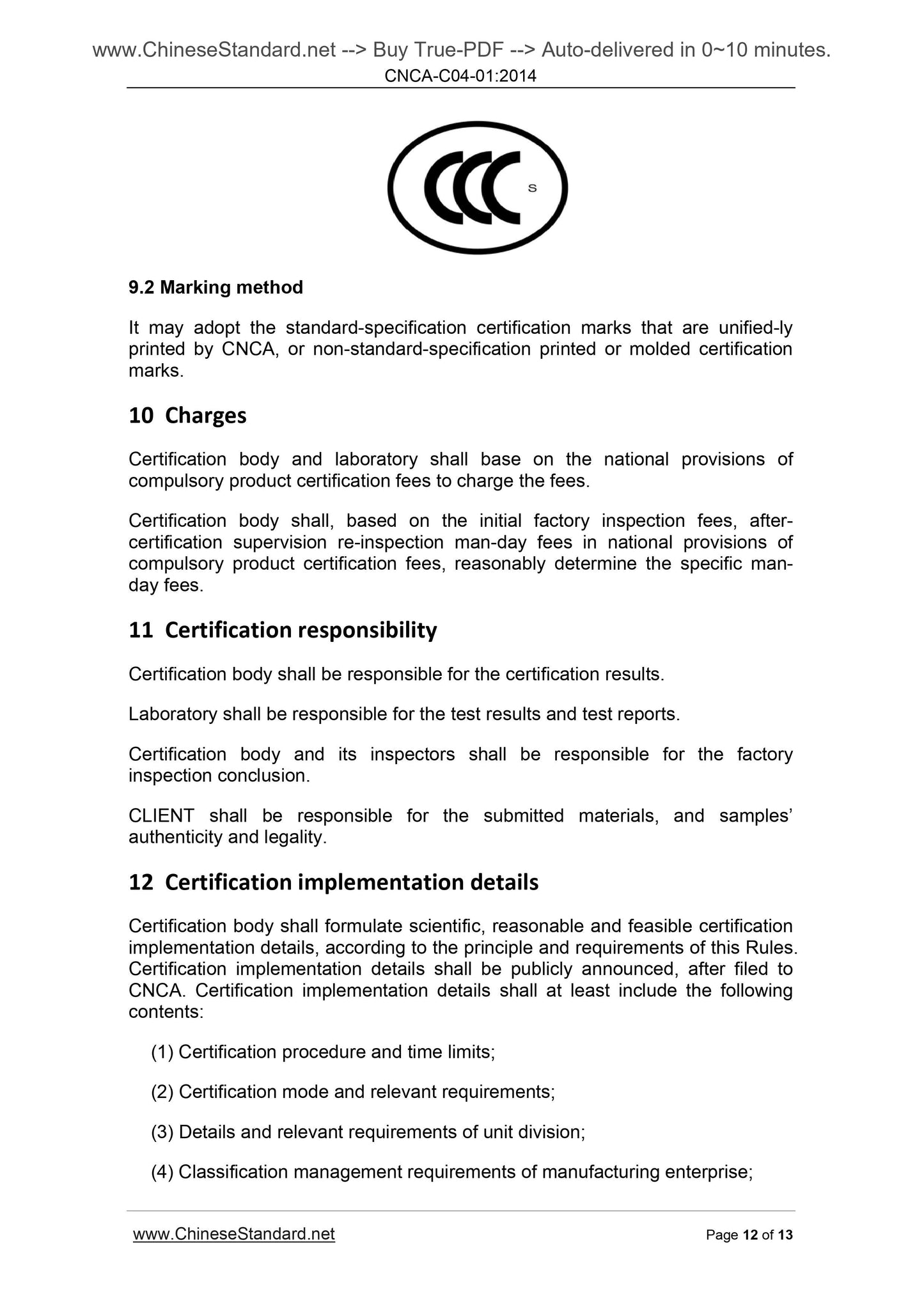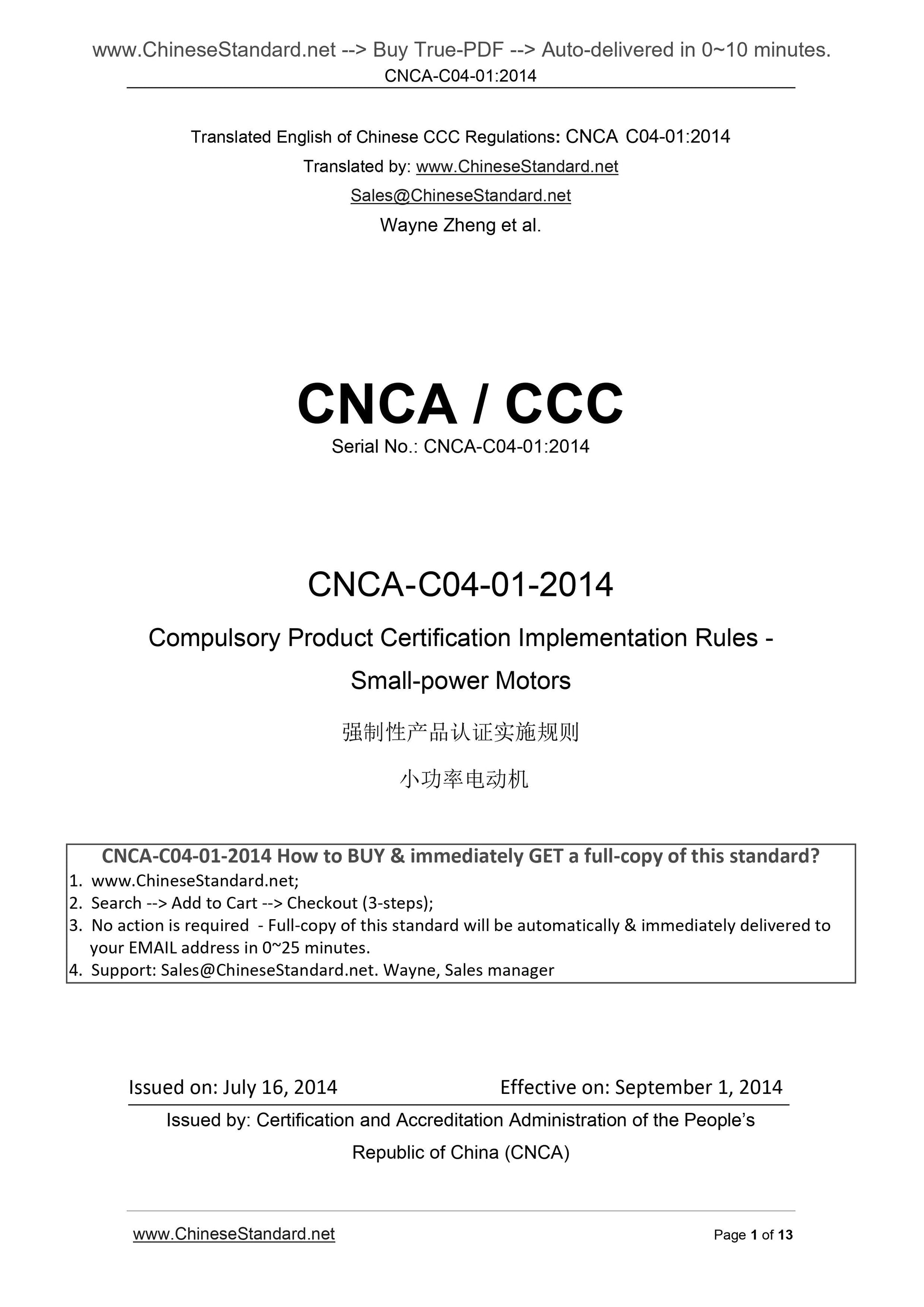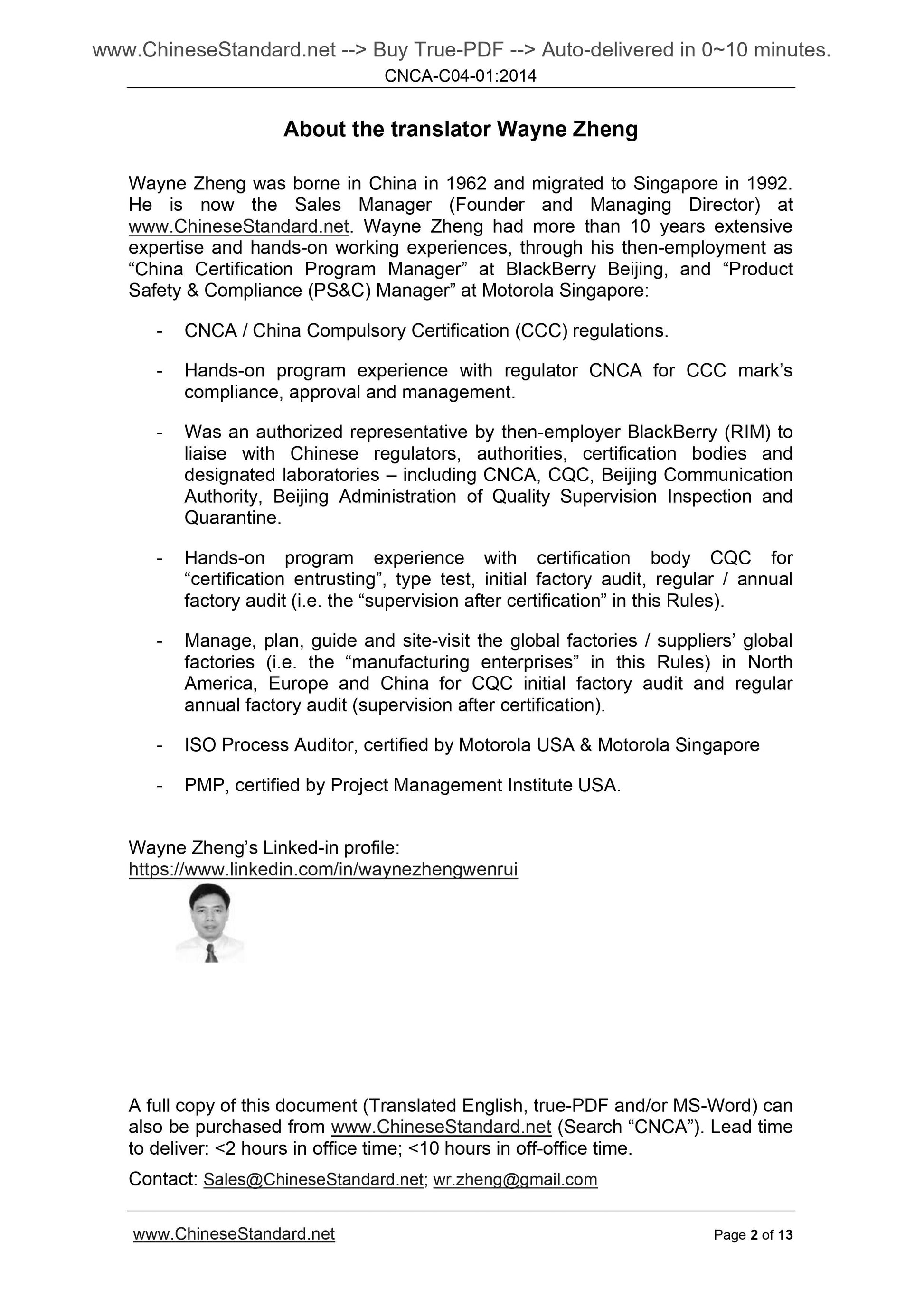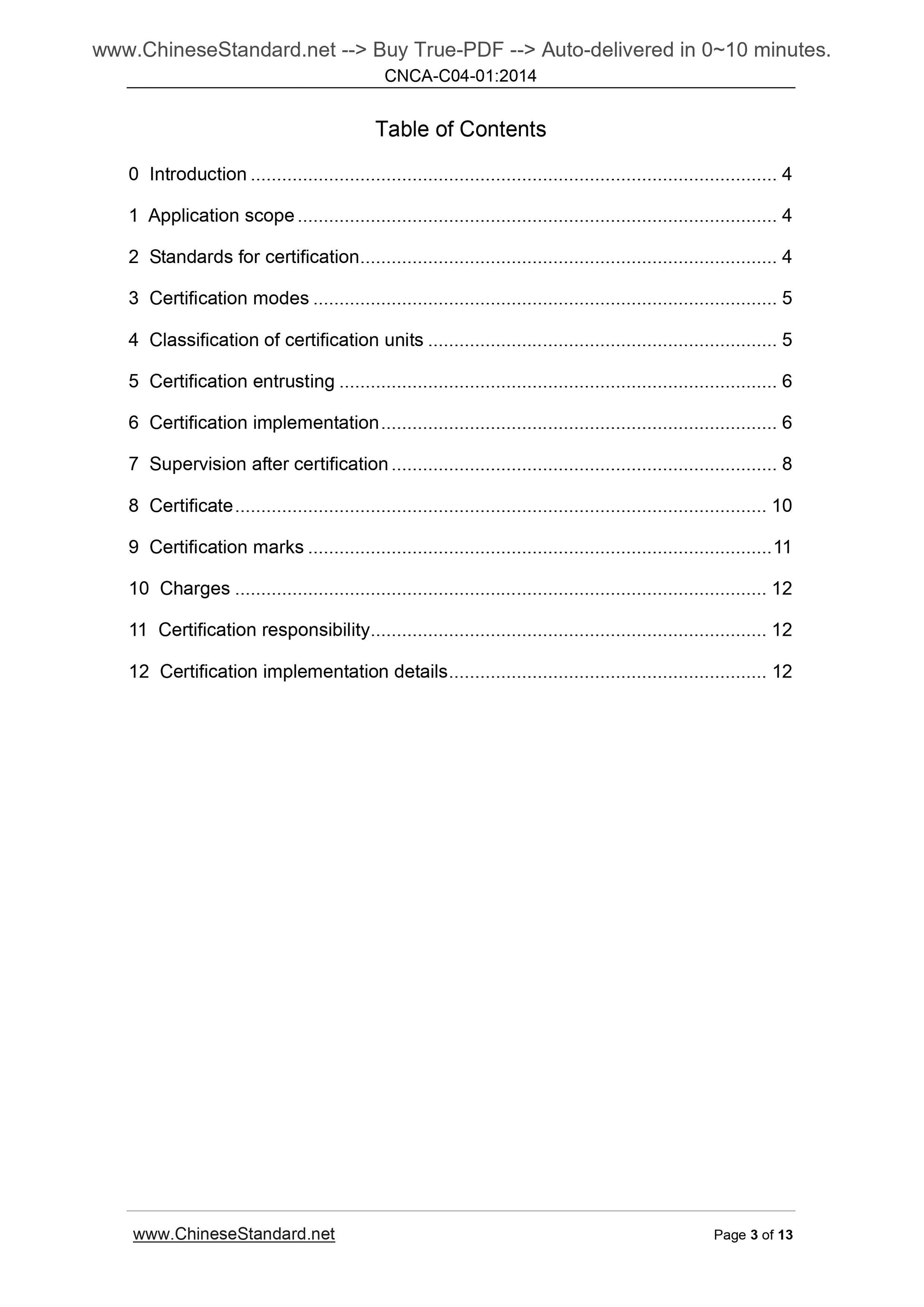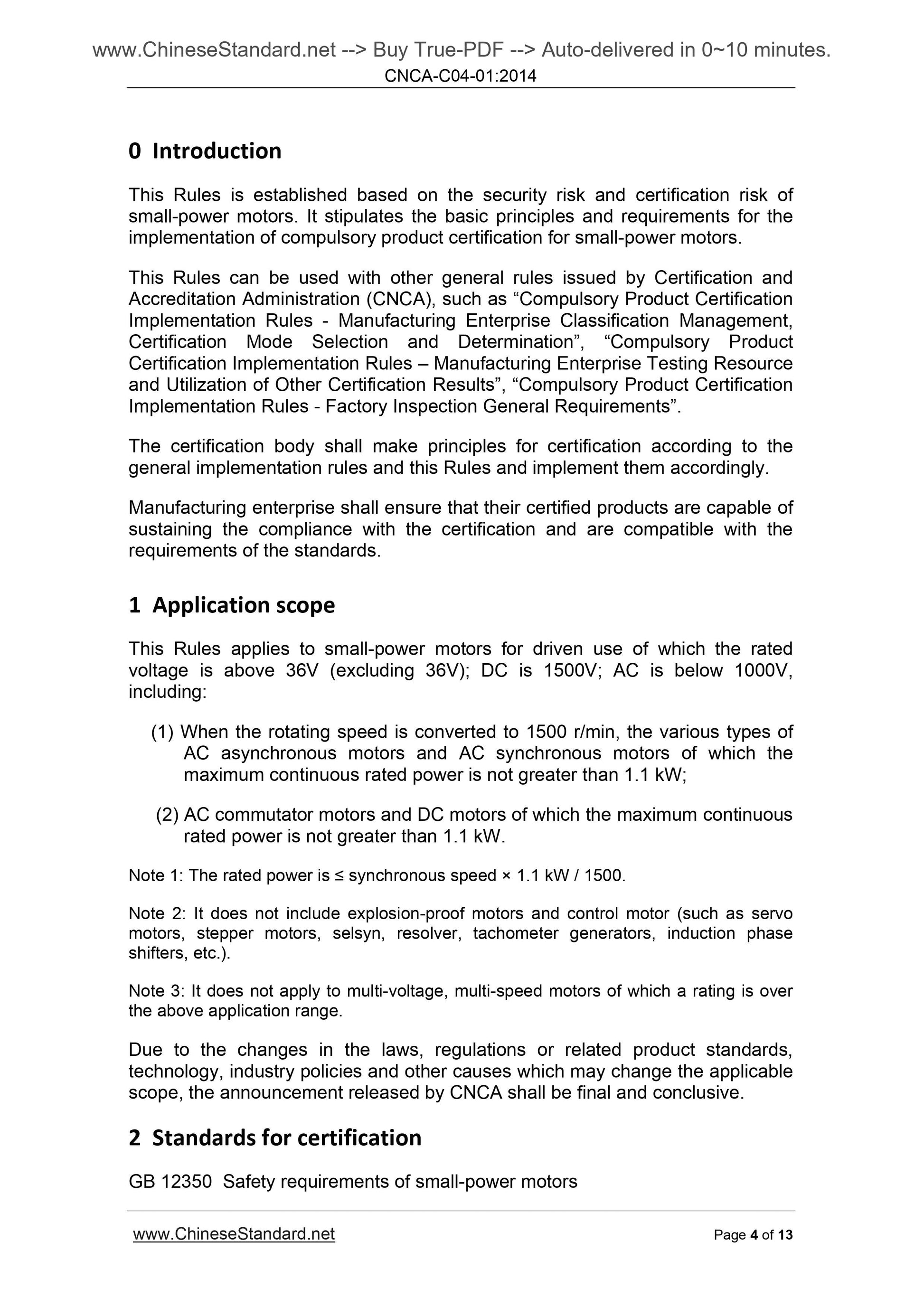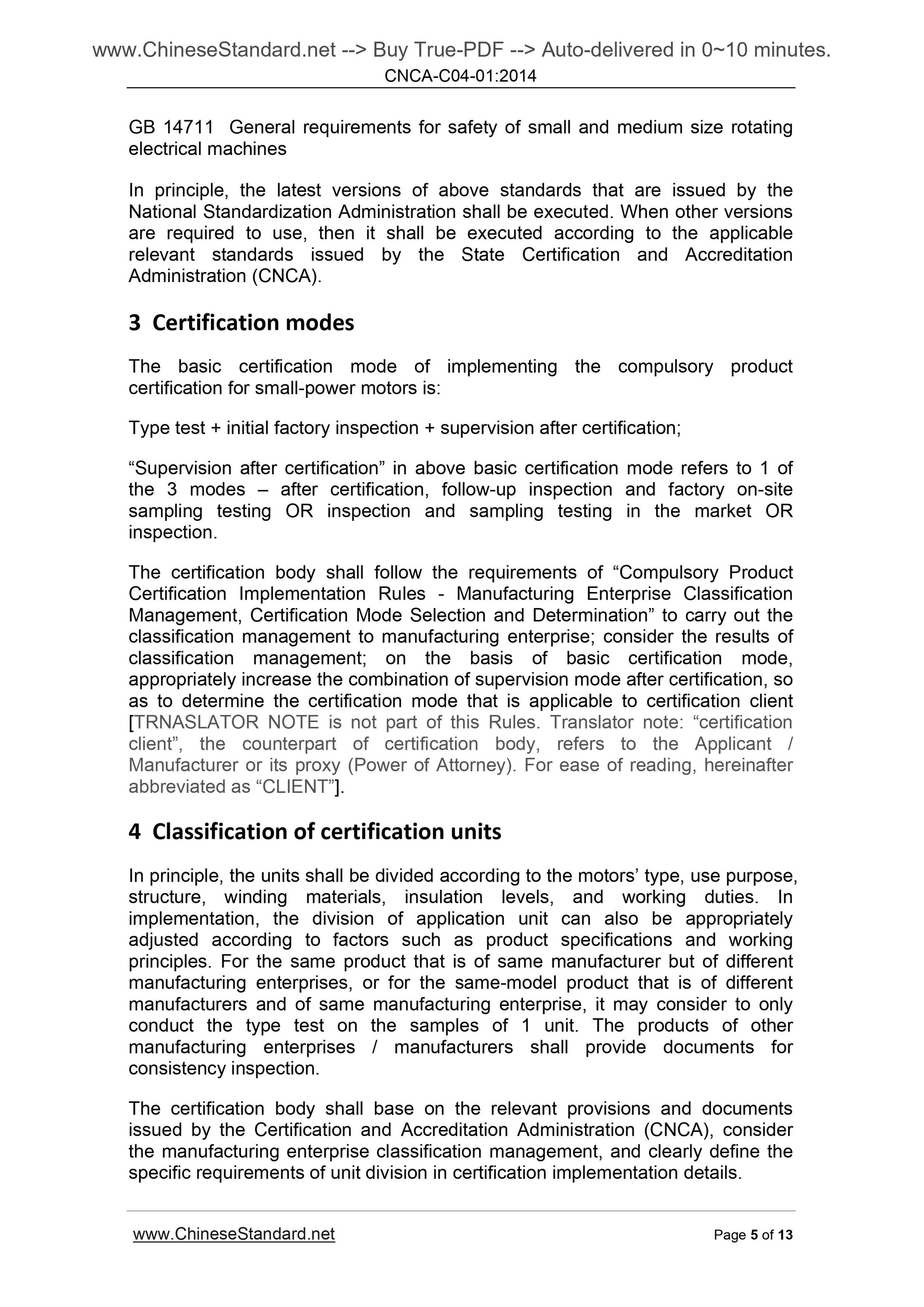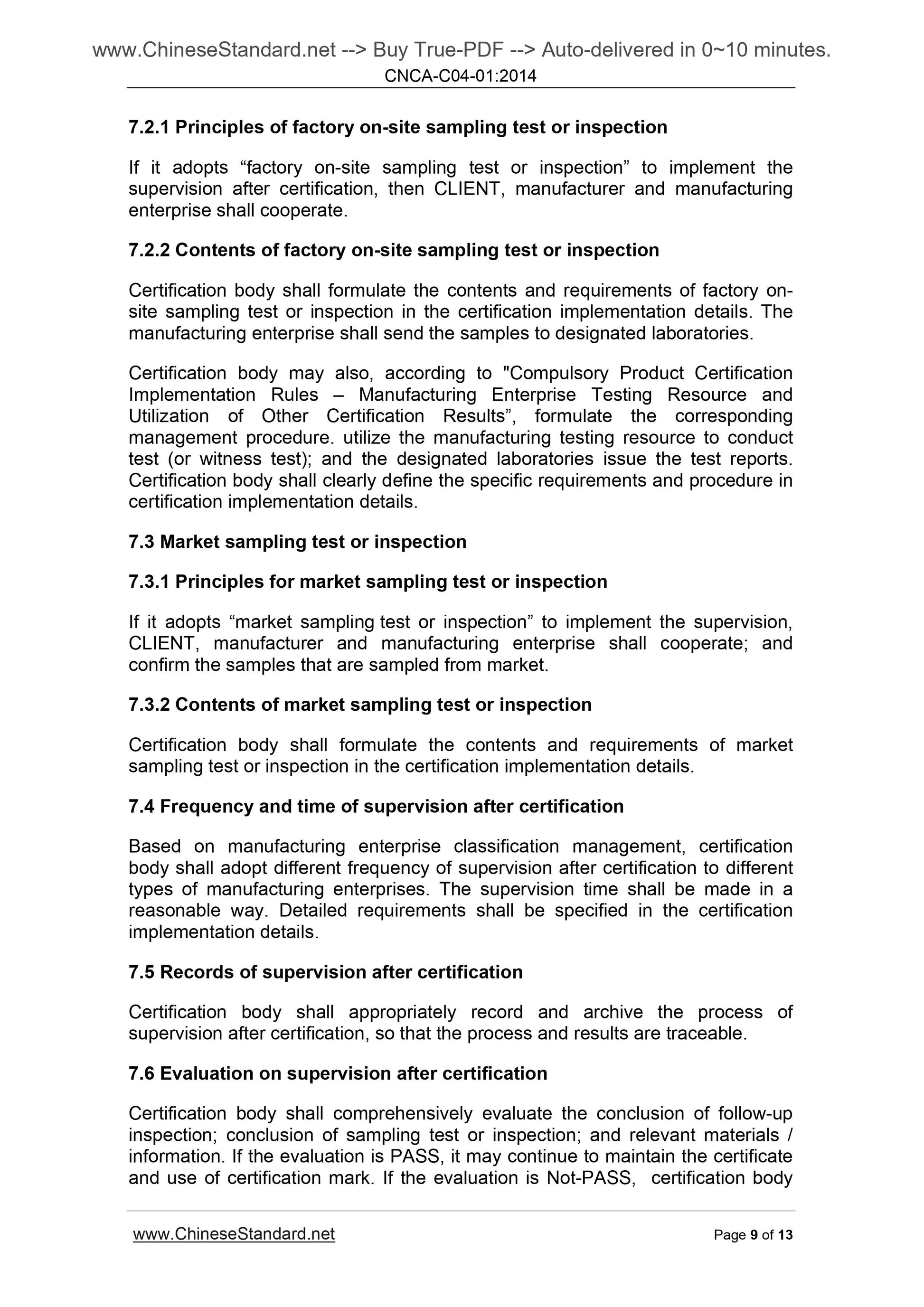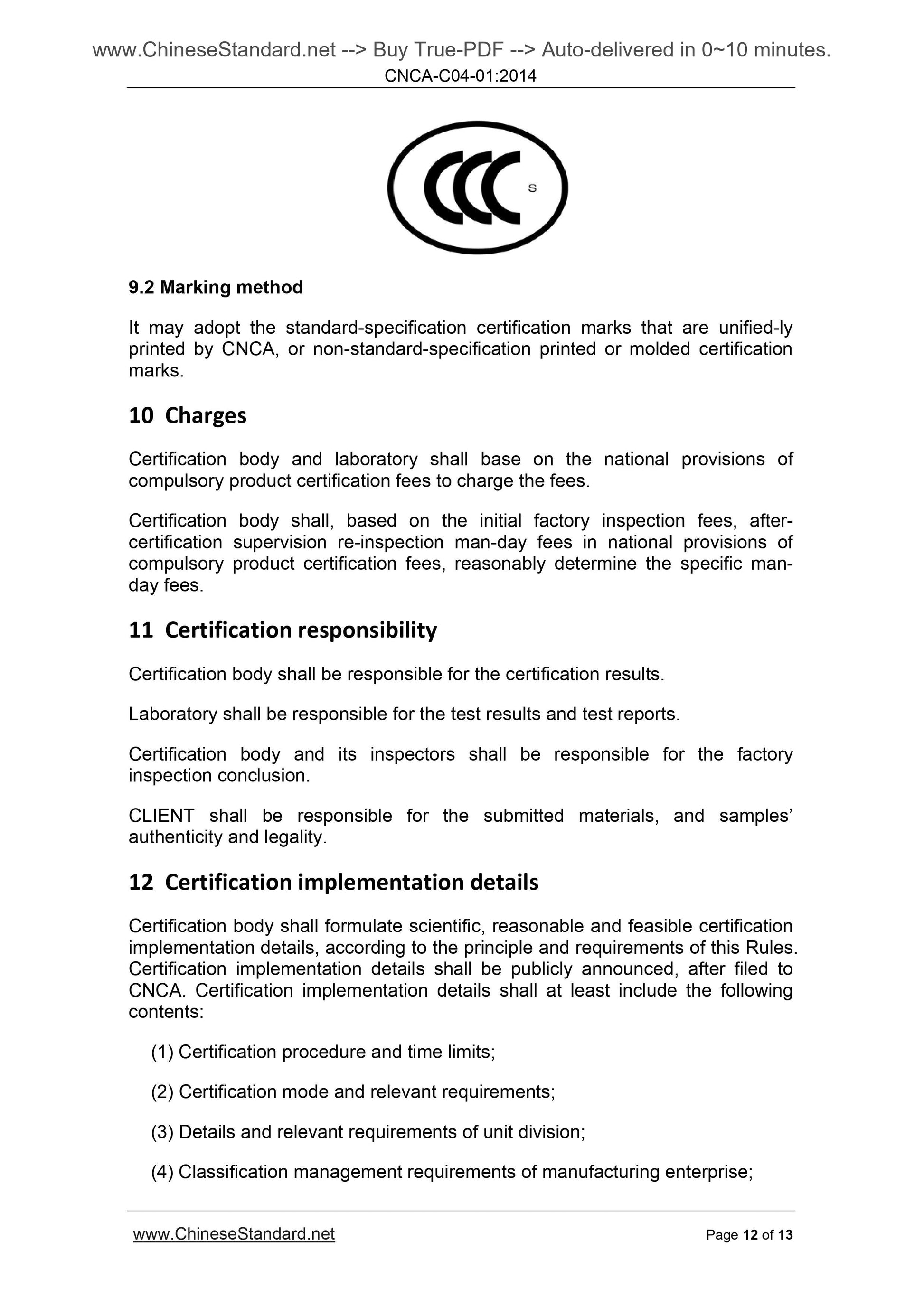1
/
の
7
PayPal, credit cards. Download editable-PDF and invoice in 1 second!
CNCA C04-01-2014 English PDF (CNCAC04-01-2014)
CNCA C04-01-2014 English PDF (CNCAC04-01-2014)
通常価格
$130.00 USD
通常価格
セール価格
$130.00 USD
単価
/
あたり
配送料はチェックアウト時に計算されます。
受取状況を読み込めませんでした
Delivery: 3 seconds. Download true-PDF + Invoice.
Get QUOTATION in 1-minute: Click CNCA C04-01-2014
Historical versions: CNCA C04-01-2014
Preview True-PDF (Reload/Scroll if blank)
CNCA C04-01-2014: China Compulsory Certification Implementation Rules - Small power motors
CNCA-C04-01.2014
CNCA / CCC
Serial No.. CNCA-C04-01.2014
CNCA-C04-01-2014
Compulsory Product Certification Implementation Rules -
Small-power Motors
Issued on. July 16, 2014 Effective on. September 1, 2014
Issued by. Certification and Accreditation Administration of the People’s
Republic of China (CNCA)
He is now the Sales Manager (Founder and Managing Director) at
expertise and hands-on working experiences, through his then-employment as
“China Certification Program Manager” at BlackBerry Beijing, and “Product
Safety and Compliance (PS and C) Manager” at Motorola Singapore.
- CNCA / China Compulsory Certification (CCC) regulations.
- Hands-on program experience with regulator CNCA for CCC mark’s
compliance, approval and management.
- Was an authorized representative by then-employer BlackBerry (RIM) to
liaise with Chinese regulators, authorities, certification bodies and
designated laboratories – including CNCA, CQC, Beijing Communication
Authority, Beijing Administration of Quality Supervision Inspection and
Quarantine.
- Hands-on program experience with certification body CQC for
“certification entrusting”, type test, initial factory audit, regular / annual
factory audit (i.e. the “supervision after certification” in this Rules).
- Manage, plan, guide and site-visit the global factories / suppliers’ global
factories (i.e. the “manufacturing enterprises” in this Rules) in North
America, Europe and China for CQC initial factory audit and regular
annual factory audit (supervision after certification).
- ISO Process Auditor, certified by Motorola USA and Motorola Singapore
- PMP, certified by Project Management Institute USA.
to deliver. < 2 hours in office time; < 10 hours in off-office time.
Table of Contents
0 Introduction ... 4
1 Application scope ... 4
2 Standards for certification ... 4
3 Certification modes ... 5
4 Classification of certification units ... 5
5 Certification entrusting ... 6
6 Certification implementation ... 6
7 Supervision after certification ... 8
8 Certificate ... 10
9 Certification marks ... 11
10 Charges ... 12
11 Certification responsibility ... 12
12 Certification implementation details ... 12
0 Introduction
This Rules is established based on the security risk and certification risk of
small-power motors. It stipulates the basic principles and requirements for the
implementation of compulsory product certification for small-power motors.
This Rules can be used with other general rules issued by Certification and
Accreditation Administration (CNCA), such as “Compulsory Product Certification
Implementation Rules - Manufacturing Enterprise Classification Management,
Certification Mode Selection and Determination”, “Compulsory Product
Certification Implementation Rules – Manufacturing Enterprise Testing Resource
and Utilization of Other Certification Results”, “Compulsory Product Certification
Implementation Rules - Factory Inspection General Requirements”.
The certification body shall make principles for certification according to the
general implementation rules and this Rules and implement them accordingly.
Manufacturing enterprise shall ensure that their certified products are capable of
sustaining the compliance with the certification and are compatible with the
requirements of the standards.
1 Application scope
This Rules applies to small-power motors for driven use of which the rated
voltage is above 36V (excluding 36V); DC is 1500V; AC is below 1000V,
including.
(1) When the rotating speed is converted to 1500 r/min, the various types of
AC asynchronous motors and AC synchronous motors of which the
maximum continuous rated power is not greater than 1.1 kW;
(2) AC commutator motors and DC motors of which the maximum continuous
rated power is not greater than 1.1 kW.
Note 1. The rated power is ≤ synchronous speed × 1.1 kW / 1500.
Note 2. It does not include explosion-proof motors and control motor (such as servo
motors, stepper motors, selsyn, resolver, tachometer generators, induction phase
shifters, etc.).
Note 3. It does not apply to multi-voltage, multi-speed motors of which a rating is over
the above application range.
Due to the changes in the laws, regulations or related product standards,
technology, industry policies and other causes which may change the applicable
scope, the announcement released by CNCA shall be final and conclusive.
2 Standards for certification
GB 12350 Safety requirements of small-power motors
GB 14711 General requirements for safety of small and medium size rotating
electrical machines
In principle, the latest versions of above standards that are issued by the
National Standardization Administration shall be executed. When other versions
are required to use, then it shall be executed according to the applicable
relevant standards issued by the State Certification and Accreditation
Administration (CNCA).
3 Certification modes
The basic certification mode of implementing the compulsory product
certification for small-power motors is.
Type test + initial factory inspection + supervision after certification;
“Supervision after certification” in above basic certification mode refers to 1 of
the 3 modes – after certification, follow-up inspection and factory on-site
sampling testing OR inspection and sampling testing in the market OR
inspection.
The certification body shall follow the requirements of “Compulsory Product
Certification Implementation Rules - Manufacturing Enterprise Classification
Management, Certification Mode Selection and Determination” to carry out the
classification management to manufacturing enterprise; consider the results of
classification management; on the basis of basic certification mode,
appropriately increase the combination of supervision mode after certification, so
as to determine the certification mode that is applicable to certification client
[TRNASLATOR NOTE is not part of this Rules. Translator note. “certification
client”, the counterpart of certification body, refers to the Applicant /
Manufacturer or its proxy (Power of Attorney). For ease of reading, hereinafter
abbreviated as “CLIENT”].
4 Classification of certification units
In principle, the units shall be divided according to the motors’ type, use purpose,
structure, winding materials, insulation levels, and working duties. In
implementation, the division of application unit can also be appropriately
adjusted according to factors such as product specifications and working
principles. For the same product that is of same manufacturer but of different
manufacturing enterprises, or for the same-model product that is of different
manufacturers and of same manufacturing enterprise, it may consider to only
conduct the type test on the samples of 1 unit. The products of other
manufacturing enterprises / manufacturers shall provide documents for
consistency inspection.
The certification body shall base on the relevant provisions and documents
issued by the Certification and Accreditation Administration (CNCA), consider
the manufacturing enterprise classification management, and clearly define the
specific requirements of unit division in certification implementation details.
7.2.1 Principles of factory on-site sampling test or inspection
If it adopts “factory on-site sampling test or inspection” to implement the
supervision after certification, then CLIENT, manufacturer and man...
Get QUOTATION in 1-minute: Click CNCA C04-01-2014
Historical versions: CNCA C04-01-2014
Preview True-PDF (Reload/Scroll if blank)
CNCA C04-01-2014: China Compulsory Certification Implementation Rules - Small power motors
CNCA-C04-01.2014
CNCA / CCC
Serial No.. CNCA-C04-01.2014
CNCA-C04-01-2014
Compulsory Product Certification Implementation Rules -
Small-power Motors
Issued on. July 16, 2014 Effective on. September 1, 2014
Issued by. Certification and Accreditation Administration of the People’s
Republic of China (CNCA)
He is now the Sales Manager (Founder and Managing Director) at
expertise and hands-on working experiences, through his then-employment as
“China Certification Program Manager” at BlackBerry Beijing, and “Product
Safety and Compliance (PS and C) Manager” at Motorola Singapore.
- CNCA / China Compulsory Certification (CCC) regulations.
- Hands-on program experience with regulator CNCA for CCC mark’s
compliance, approval and management.
- Was an authorized representative by then-employer BlackBerry (RIM) to
liaise with Chinese regulators, authorities, certification bodies and
designated laboratories – including CNCA, CQC, Beijing Communication
Authority, Beijing Administration of Quality Supervision Inspection and
Quarantine.
- Hands-on program experience with certification body CQC for
“certification entrusting”, type test, initial factory audit, regular / annual
factory audit (i.e. the “supervision after certification” in this Rules).
- Manage, plan, guide and site-visit the global factories / suppliers’ global
factories (i.e. the “manufacturing enterprises” in this Rules) in North
America, Europe and China for CQC initial factory audit and regular
annual factory audit (supervision after certification).
- ISO Process Auditor, certified by Motorola USA and Motorola Singapore
- PMP, certified by Project Management Institute USA.
to deliver. < 2 hours in office time; < 10 hours in off-office time.
Table of Contents
0 Introduction ... 4
1 Application scope ... 4
2 Standards for certification ... 4
3 Certification modes ... 5
4 Classification of certification units ... 5
5 Certification entrusting ... 6
6 Certification implementation ... 6
7 Supervision after certification ... 8
8 Certificate ... 10
9 Certification marks ... 11
10 Charges ... 12
11 Certification responsibility ... 12
12 Certification implementation details ... 12
0 Introduction
This Rules is established based on the security risk and certification risk of
small-power motors. It stipulates the basic principles and requirements for the
implementation of compulsory product certification for small-power motors.
This Rules can be used with other general rules issued by Certification and
Accreditation Administration (CNCA), such as “Compulsory Product Certification
Implementation Rules - Manufacturing Enterprise Classification Management,
Certification Mode Selection and Determination”, “Compulsory Product
Certification Implementation Rules – Manufacturing Enterprise Testing Resource
and Utilization of Other Certification Results”, “Compulsory Product Certification
Implementation Rules - Factory Inspection General Requirements”.
The certification body shall make principles for certification according to the
general implementation rules and this Rules and implement them accordingly.
Manufacturing enterprise shall ensure that their certified products are capable of
sustaining the compliance with the certification and are compatible with the
requirements of the standards.
1 Application scope
This Rules applies to small-power motors for driven use of which the rated
voltage is above 36V (excluding 36V); DC is 1500V; AC is below 1000V,
including.
(1) When the rotating speed is converted to 1500 r/min, the various types of
AC asynchronous motors and AC synchronous motors of which the
maximum continuous rated power is not greater than 1.1 kW;
(2) AC commutator motors and DC motors of which the maximum continuous
rated power is not greater than 1.1 kW.
Note 1. The rated power is ≤ synchronous speed × 1.1 kW / 1500.
Note 2. It does not include explosion-proof motors and control motor (such as servo
motors, stepper motors, selsyn, resolver, tachometer generators, induction phase
shifters, etc.).
Note 3. It does not apply to multi-voltage, multi-speed motors of which a rating is over
the above application range.
Due to the changes in the laws, regulations or related product standards,
technology, industry policies and other causes which may change the applicable
scope, the announcement released by CNCA shall be final and conclusive.
2 Standards for certification
GB 12350 Safety requirements of small-power motors
GB 14711 General requirements for safety of small and medium size rotating
electrical machines
In principle, the latest versions of above standards that are issued by the
National Standardization Administration shall be executed. When other versions
are required to use, then it shall be executed according to the applicable
relevant standards issued by the State Certification and Accreditation
Administration (CNCA).
3 Certification modes
The basic certification mode of implementing the compulsory product
certification for small-power motors is.
Type test + initial factory inspection + supervision after certification;
“Supervision after certification” in above basic certification mode refers to 1 of
the 3 modes – after certification, follow-up inspection and factory on-site
sampling testing OR inspection and sampling testing in the market OR
inspection.
The certification body shall follow the requirements of “Compulsory Product
Certification Implementation Rules - Manufacturing Enterprise Classification
Management, Certification Mode Selection and Determination” to carry out the
classification management to manufacturing enterprise; consider the results of
classification management; on the basis of basic certification mode,
appropriately increase the combination of supervision mode after certification, so
as to determine the certification mode that is applicable to certification client
[TRNASLATOR NOTE is not part of this Rules. Translator note. “certification
client”, the counterpart of certification body, refers to the Applicant /
Manufacturer or its proxy (Power of Attorney). For ease of reading, hereinafter
abbreviated as “CLIENT”].
4 Classification of certification units
In principle, the units shall be divided according to the motors’ type, use purpose,
structure, winding materials, insulation levels, and working duties. In
implementation, the division of application unit can also be appropriately
adjusted according to factors such as product specifications and working
principles. For the same product that is of same manufacturer but of different
manufacturing enterprises, or for the same-model product that is of different
manufacturers and of same manufacturing enterprise, it may consider to only
conduct the type test on the samples of 1 unit. The products of other
manufacturing enterprises / manufacturers shall provide documents for
consistency inspection.
The certification body shall base on the relevant provisions and documents
issued by the Certification and Accreditation Administration (CNCA), consider
the manufacturing enterprise classification management, and clearly define the
specific requirements of unit division in certification implementation details.
7.2.1 Principles of factory on-site sampling test or inspection
If it adopts “factory on-site sampling test or inspection” to implement the
supervision after certification, then CLIENT, manufacturer and man...
Share
